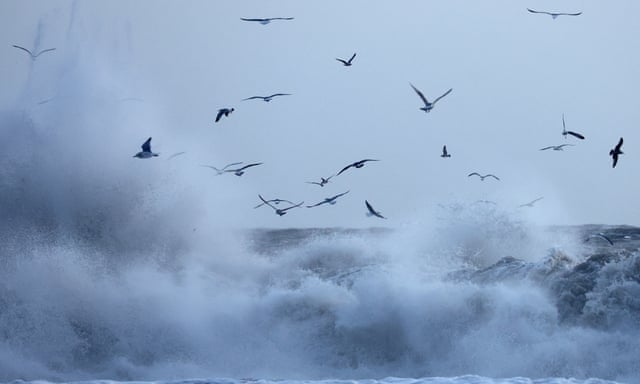Ocean spray can carry sewage bacteria into coastal communities, new research has shown.
Photograph: Mario Tama/Getty Images
Photograph: Mario Tama/Getty Images
From The Guardian by Katharine Gammon
Pathogens such as E coli, norovirus and salmonella can be blown miles into coastal communities after a rainstorm
After a rainstorm passes, the air coming off the ocean just feels different – cleaner and fresher.
But a first of its kind study shows how bacteria from sewage in the ocean can get whipped up in salt spray and blow into coastal communities miles away, a phenomenon exacerbated by storm runoff.
The study, released on Thursday by researchers at the Scripps Institution of Oceanography, looked at an area south of San Diego near the US-Mexico border, where a Mexican wastewater treatment plant often becomes overwhelmed and spews sewage into the Tijuana River.
That river then flows north into Imperial Beach on the northern side of the border.
The beach there was closed 249 days last year due to high levels of pathogens like E coli, norovirus and salmonella – but until now, little was known about what happened when crashing waves sent salt spray into the air.
A team of researchers sampled coastal aerosols at Imperial Beach and water from the Tijuana River for 26 days between January and May 2019, focusing on times after storms.
They used DNA sequencing to match bacteria and chemical compounds in coastal aerosols back to the sewage-polluted Tijuana River flowing into the ocean.
They found that three-quarters of the bacteria in the air came directly from the sewage in the surf zone.
It’s not yet clear whether these bacteria can make people sick, and experts are exploring the possible harms.
“Are they potentially infectious? Some are pathogens and some are not.
That’s something we’re working on now,” says Kim Prather, an atmospheric chemist at Scripps who led the work, which was published today in the journal Environmental Science and Technology.
While the degree of risks remain unknown, the study is significant because it is the first time scientists have linked such pollution to coastal sea spray.
It’s also the first time scientists have been able to quantify how much of the microbes in the air are traceable back to microbes in the sewage contaminated water, says Rob Knight, a researcher at San Diego School of Medicine and Jacobs School of Engineering, who worked on the study.
“Now we know this is a real phenomenon, we need to figure out the impacts for human health,” he says.
Prather adds that these pathogens are typically thought of as food borne or waterborne.
“There has been a huge focus on them being in the water, and not so much in the air,” she says.
“We really don’t have any studies that say what would happen if you inhale these, this is a different exposure pathway than we have thought about, that anybody has thought about, before.”
The team found the pathogens present a mile or two inland – and there is evidence that coastal salt spray can be blown hundreds of miles inland, but particles get more dispersed as they move away from the coast, Prather says.
“We don’t know what the effect is yet of inhaling this cocktail that comes out of the ocean – it’s something we are trying to understand.” They are currently in the process of starting another study in the area that would spend 40 straight days sampling the air for bacteria, viruses and chemicals stemming from water pollution.
Surfers head out to waves in Imperial Beach, California, where researchers monitored the air and water after storms.
Photograph: Eduardo Contreras/AP
Photograph: Eduardo Contreras/AP
Aerosols have been a hot topic in recent years, because of the nature of Covid-19 – but environmental scientists have been studying aerosols like wildfire smoke or sea spray for decades.
When waves break, about 20% of the bacteria present break off easily from the water and bubble up into the air.
Prather describes the process as a “hydrophobic goo that doesn’t like water, so it will almost float like oil on the surface of the ocean”.
When waves crash and bubbles burst, that material launches into the air.
Storms also release a huge amount of raw sewage into our waterways – from pet waste on streets to treatment plants that can flood like the one in Mexico.
If the surf is high and there’s a lot of white foam, the conditions are primed for bacteria to be sent spewing into the air, says Prather.
In just the past few weeks alone, during a series of brutal rainstorms in California that began on 28 December, an estimated 13bn gallons of raw sewage have been released into the waters around San Diego.
“So there’s a lot more microbes in the water right now – more than maybe ever before.”
Matthew Pendergraft, a recent graduate from Scripps Oceanography who obtained his doctorate under the guidance of Prather, says that rain should clean out any air pollution, but it comes down to an infrastructure problem that’s causing the polluted water.
“This research demonstrates that people in coastal communities like Imperial Beach are exposed to coastal water pollution even without entering that water.
Basic aerosol science states that these aerosols will travel further downwind than just on the beach.”
After storms, bacterial levels can remain elevated for three days or more, according to the LA county department of public health.
Prather says she thinks about air quality every time a beach is closed due to high levels of bacteria in the water, and she could see a future where warning signs are posted about breathing salty air on those days.
“The dream would be to determine certain conditions where it’s bad to breathe the air,” she says.
“We’d be able to do warnings for the public – just alerts like we do for high pollution days, where people who have sensitive lungs or young kids should be more cautious.”


No comments:
Post a Comment